Horseman Pouter Pigeon: History And Breed Guide
The horseman pouter pigeon is a pigeon you can call an all-rounder. It is good for breeding, flying, business, and low maintenance as well. Sounds like a total package, doesn’t it?
Moreover, its beauty is unique in its own way. These pigeon breeds are great thieves. They are good at stealing things that appeal to them. It includes mates of other pigeons as well.
After all, they are really great at courtship and that’s why they are often used to attract other pigeons.
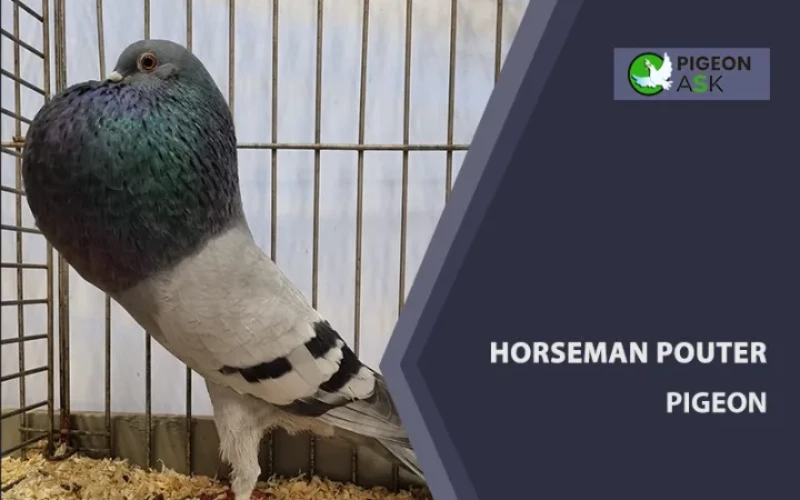
In this article, you will get a complete overview of the horseman pouter pigeon, its characteristics, utility, habitat and breeding. Trust me, it’s about to get really interesting from here. So, let’s get started!
Horseman Pouter Pigeon Profile
| Name | Features |
|---|---|
| Scientific Name | Columbia livia |
| Common Names | Big Doos, Horseman Thief Pouter |
| Origin | Spain |
| Size | 9 to 11 inches |
| Lifespan | 7 to 10 years |
| Physical Features | Wedge-shaped with large inflated balloon-like crop |
| Temperament | Friendly |
| Behavior | Seductive and promiscuous |
| Special Features | Excellent homing instinct, flying ability and intelligence |
| Breeding and Maintenance | Low maintenance |
| Common or Popular Varieties | Grizzle, White Grizzle, Indigo, Spread, Almond, Dominate Opal, Recessive Red Andalusian, Powder and Tortoiseshell. |
Interested in similar topics on pigeon breed:
Overview
The horseman pouter pigeon, also called the “Horseman Thief” pouter pigeon or the “Big Doos,” is a pigeon breed popularly used for capturing other pigeons.
It is actually a sport of utilizing pigeons to capture other pigeons, where the horseman pouter has been a top choice for years.
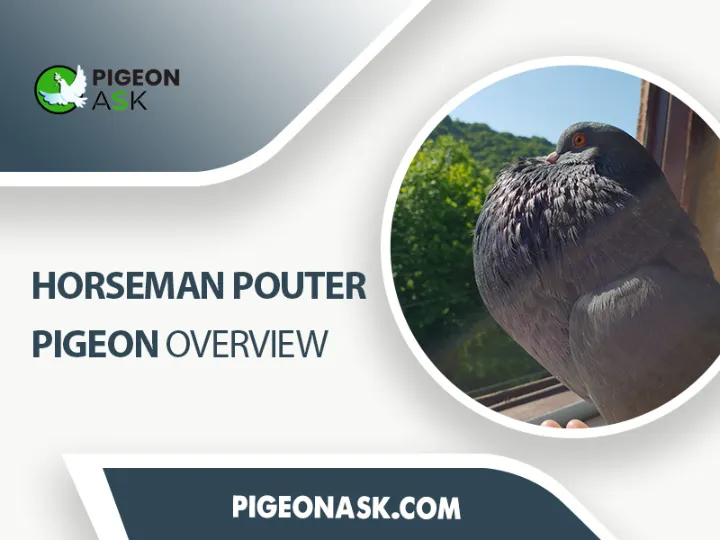
There are basically three types of this pigeon. They are working, flying and show pigeons. Again, some pigeons are selected for both flying and show purposes, they are called “dual purpose” horseman pouters.
The working pigeons are good thieves. But alongside that, they are also utilized to seduce other pigeons back to their loft. The show pigeons can be good thieves as well, but not always.
It usually depends on their mood. They are used for show business. And flying pigeons are pets to owners who enjoy their flight.
History and Origins of Horseman Pouter Pigeons
The horseman pouter was first discovered somewhere around Spain in the 16th or 17th century.
However, they grew to fame because of their higher abundance in Glasgow, Scotland. And that’s the reason why bird fanciers consider them a Scottish breed.
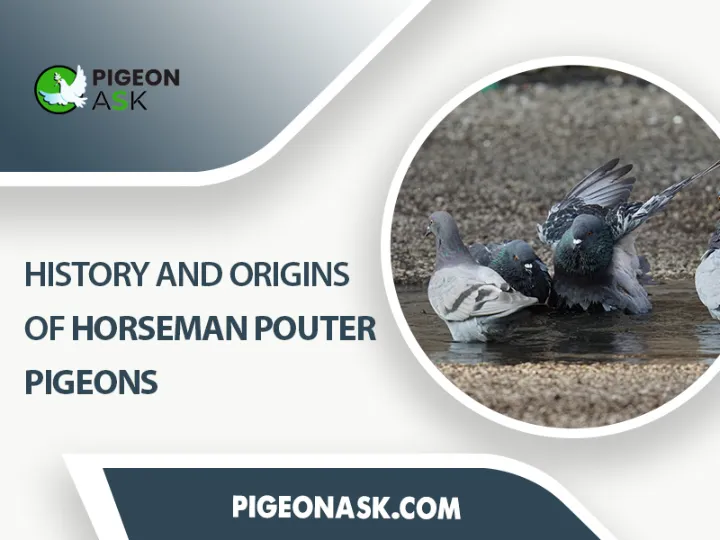
They reached the market of America much later, in the 21st century. Their first import to the USA was in 4 pairs in 2004.
From a few old records, it is found that this breed was created through careful crossbreeding between pouter pigeons and the carrier Horseman, which is now extinct.
Later, they were mixed with various other breeds to improve their skills as working birds. And so they are now available in different shapes, sizes and colors.
Physical Characteristics and Features
The physical features and characteristics of the horseman pouter are similar to other pouter pigeons.
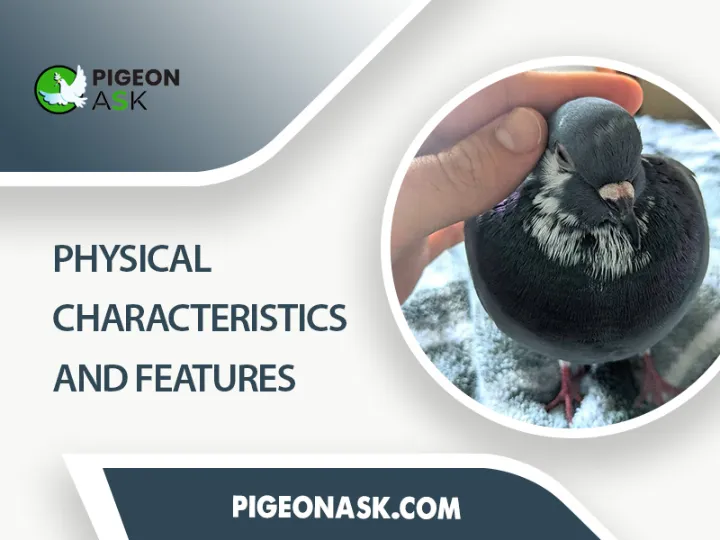
But it has its own properties that make it unique from the rest to some levels. Let’s take a look at them.
| Feature | Description |
|---|---|
| Plumage Coloration | Solid white |
| Feather Patterns | Self-colored |
| Eye Color | Deep red/maroon |
| Beak Structure | Medium-sized, slender, slightly curved |
| Head Shape | Smoothly rounded, elongated |
| Legs and Feet | Dark red/crimson, moderately long, slender |
| Body Size | Medium, graceful, 30-32 cm |
| Wing Shape | Primary feathers: long, strong, slightly pointed |
| Tail Length and Shape | Moderately long, wedge-shaped, tapering to a fine point |
| Crest or Crown | Absent |
| Neck Length and Thickness | Moderately long, proportionate to the body |
| Cere or Wattle | Absent |
| Iris Ring | Narrow black ring |
| Body Posture | Upright, chest held forward, tail slightly elevated |
| Vent Area | Soft, fluffy feathers, clean and tidy |
Appearance
Well, the look of the horseman pouter might seem to be like just another pouter pigeon with a large balloon-like crop, at first glance. But it is medium-sized compared to all other pouter pigeons.
And when I say medium-sized, it includes all of its parts like legs, beak, keel and wings.
Size and Body Structure
The horseman pouter is wedge-shaped. It’s not small like Brunner pouters but also not too large or wide, somewhere around 9 to 11 inches from head to foot.
Has a roach back and a round chest. The keel of this pigeon is long and straight and it extends up to the leg or hip joint. Its wings held tight to its body.
Unique Features
Among the unique and eye-catching physical features of the Horseman pouter, its large, inflated balloon-like crop is the most prominent. This is a feature only unique for pouter pigeons and it makes them different from the generalized shape of a bird.
Some Common Variation in Colors and Markings Across Different Species
The horseman pouter pigeon is available in a variety of different colors.
Among them, the most common ones include base colors of Black, White, Indigo, Dominant Opal, Silver, Brown, Blue and Ash Red. They possess patterns like Bar, Checker and T-Checker.
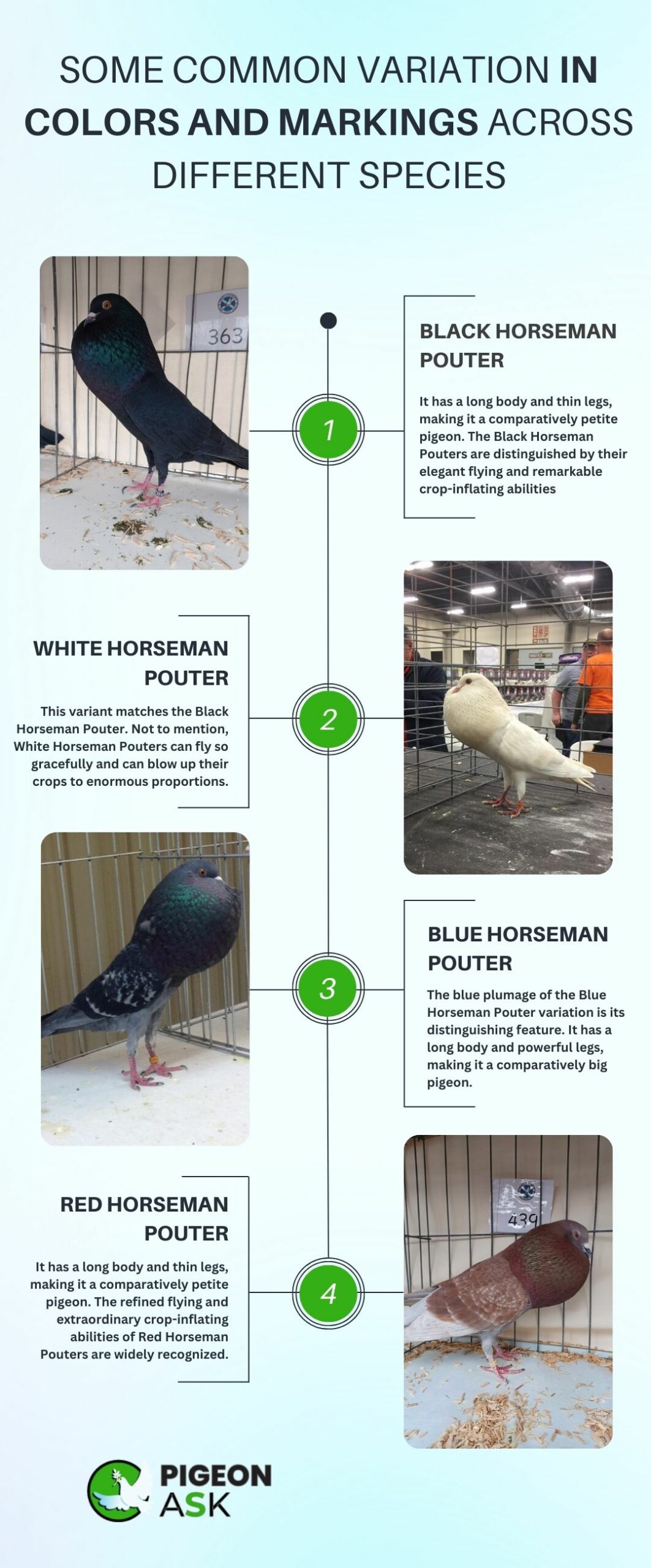
Some of the major varieties of the horseman pouter pigeon is given below—
01. Black Horseman Pouter
The sleek, black feathers of this type are its distinguishing feature. It has a long body and thin legs, making it a comparatively petite pigeon. The Black Horseman Pouters are distinguished by their elegant flying and remarkable crop-inflating abilities.
02. White Horseman Pouter
Though with white plumage, this variant matches the Black Horseman Pouter. Not to mention, White Horseman Pouters can fly so gracefully and can blow up their crops to enormous proportions.
03. Blue Horseman Pouter
The blue plumage of the Blue Horseman Pouter variation is its distinguishing feature. It has a long body and powerful legs, making it a comparatively big pigeon.
The Blue Horseman Pouters are renowned for their strong flight and capacity to dramatically inflate their crops.
04. Red Horseman Pouter
The red feathers of this type are its distinguishing feature. It has a long body and thin legs, making it a comparatively petite pigeon. The refined flying and extraordinary crop-inflating abilities of Red Horseman Pouters are widely recognized.
Distribution And Habitat
Horseman Pouter’s widespread fame from Scotland to different parts of the world is not a mystery. After all, its beauty and utility make it very demanding among all the pigeon breeders and traders.
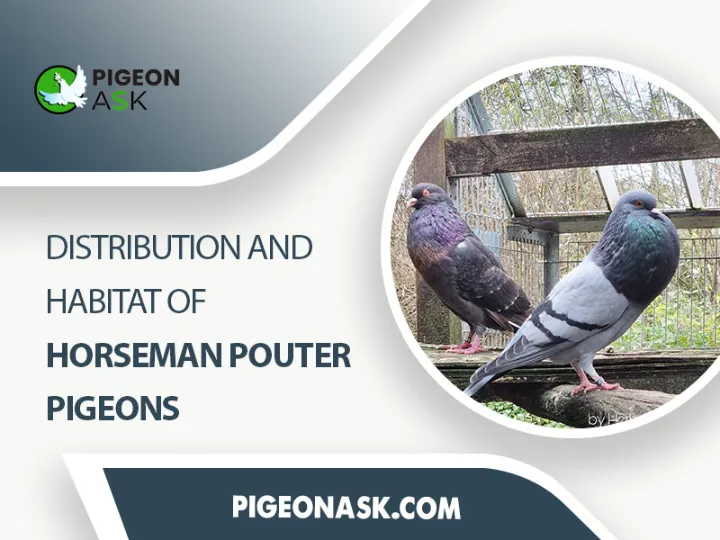
Let’s dig deeper into how it’s distributed worldwide.
Geographic Distribution
It is assumed that the horseman pouter pigeon moved from Spain to Scotland, where it rose to fame during the 17th century. Later, it was distributed all across Europe, where it has been specially utilized as working pigeons.
In the year 2004, it finally reached the US market, and from then on, it became available in other countries of the world.
Habitat Preferences
Horseman pouters are quite flexible dwellers. They can be easily kept in lofts with other pigeons inside the homes of the owners, in shops and in circuses.
However, they prefer well-ventilated, safe from predators and clean lofts. Therefore, proper maintenance of their loft is crucial, like most other pigeons.
Urban and Rural Habitats
The Horseman pouters are more popular and evident in cities than in villages.
Because of their working and seducing ability, they are kept more in the cities to capture other birds and utilize them in show businesses.
Moreover, in cities like Glasgow and Edinburgh, they are used for competition to capture more pigeons.
Migration and Seasonal Movements
Horseman pouter do not really migrate. Rather, they are famous for always finding their way back and bringing more birds with them.
However, they are widespread all around the world as they are one of the most densely exported pigeon breeds.
Behavior And Traits of Horseman Pouter Pigeons
When it comes to behavioral traits, the Horseman pouters are one-of-a-kind seducers. And their breeding performance is what makes them extremely popular among pigeon breeders.
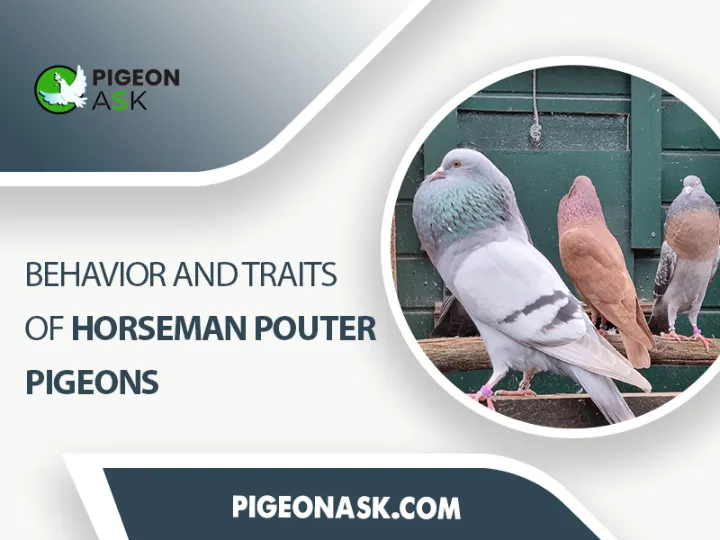
Though besides their performance, they have many more impressive traits like excellent homing instinct, flying ability, intelligence and much more given below.
Temperament
The ability of horseman pouters to attract other pigeons is quite unmatchable. And so, in the loft, they play the role of the popular playboy who goes along well with everyone. They are also super friendly with their owners.
Besides, they are highly intelligent and have great agility as well.
Flight
There is a type of horseman pouter solely dedicated to flying. Because the horseman pouters possess quite impressive flying ability. It is the reason why they are used in shows as well as kept as pets and working pigeons.
Breeding and Courtship
The money feature of horseman pouters is their breeding and courtship abilities. They have a high sex drive and are extremely promiscuous.
But despite that, they make great parents as well. Their ability to seduce other pigeons is absolutely applaudable.
Homing Instinct
Horseman pouters bear impeccable homing instincts. They can move or be left further away from their loft to attract mates, but they always find their way back to their loft.
Diet
Horseman pouters do not eat anything different from other pigeons. Usually, vegetables, fruits and seeds work well for them.
Their nutrient requirements contain nuts and berries to be fed occasionally. Safflower seeds and garlic are good for their feathers.
Breeding And Maintenance
At the heart of breeding success lies the selection of the breeding pair. Both parents must be purebred Horseman Pouter pigeons exhibiting all the desired breed characteristics.
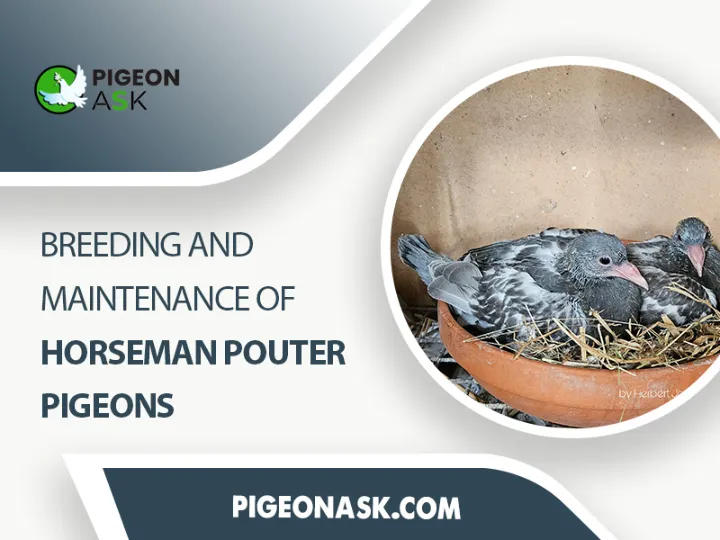
Look for birds with sturdy health, at least one year of age, and free from any visible signs of illness or deformity.
Information About Raising and Breeding
Horseman pouters are one of the very few low-maintenance birds. There isn’t much information about raising and breeding a horseman pouter to share.
Even the least maintenance, including ensuring proper feeding and housing requirements, is enough for them to live well.
However, it is necessary to make sure they have the opportunity to make and attract mates. As they are high in sex drive, not having enough options to mate might make them frustrated.
Final Words
Horseman pouter pigeons are one of the top choices of breeders. They can reproduce much more than any other pigeon.
And so, if you want to increase the population of your loft without spending money on a number of pigeons, getting a horseman pouter can do the work for you.
Do you think any of your friends would be interested in knowing about this fascinating breed of pigeon?
Then, let them learn about it by sharing this article on your Facebook, Twitter and Google News!
